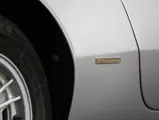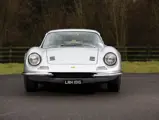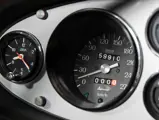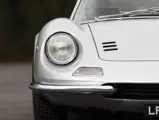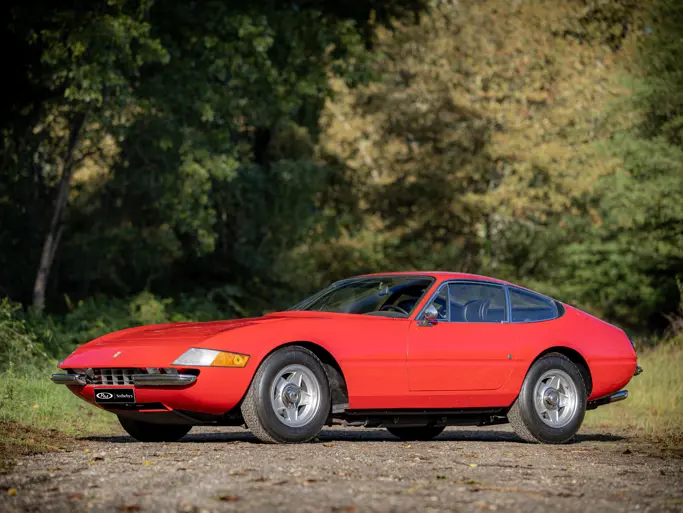Paris 2017
1968 Ferrari Dino 206 GT by Scaglietti
{{lr.item.text}}
€526,400 EUR | Sold
 | Paris, France
| Paris, France
{{internetCurrentBid}}
{{internetTimeLeft}}

- Ferrari Classiche certified
- One of only 154 aluminium-bodied Dino 206s produced
- Finished in its original colours of Argento Auteuil Metallizzato over Nero with blue cloth inserts
- Certificat Ferrari Classiche
- Une des 154 Dino 206 à carrosserie aluminium
- Teintes d'origine "Argento Auteuil Metallizzato" avec intérieur noir et inserts en tissu bleu
180 bhp, 1,987 cc DOHC Tipo 135 B transversely mounted alloy V-6 engine with three Weber carburettors, five-speed manual transmission, front and rear independent wishbone suspension with coil springs and telescopic dampers, and four-wheel ventilated disc brakes. Wheelbase: 2,280 mm
Moteur V6 alliage transversal Tipo 135 B, 1 987 cm³, 2 ACT par banc, 180 ch, transmission manuelle à cinq rapports, suspensions avant et arrières triangulées avec ressorts hélicoïdaux et amortisseurs télescopiques, freins à disque ventilés sur les quatre roues. Empattement : 2 280 mm
Veuillez noter que cette Dino est accompagnée d'un bloc-moteur du type conforme à l'origine.
The importance of the Dino as Ferrari’s first production, mid-engined sports car should not be underestimated. The car’s DNA runs through all subsequent two-seater models through to today’s 488 GTB and Spider.
The Dino name had already appeared in relation to a number of Ferrari V-6 racing engines in the late 1950s and ’60s as a tribute to Enzo Ferrari’s son Alfredo ‘Dino’ Ferrari, who had participated in the development of these engines before tragically passing away at the age of 24. However, the road car project was born of a joint venture with Fiat to provide a V-6 Dino engine for a run of a new high-performance Fiat GT car. Timing of the launch was designed to coincide with the need for a homologated V-6 engine block for the 1967 Formula 2 season. Following a couple of years of development, Ferrari eventually launched its own Dino in 1968.
Chassis number 00238 is one of only 154 206 GT Dinos built, incorporating aluminium bodywork. The car was delivered new to Rome and in the early years of its life it passed through the hands of a succession of Italian owners in Rome, and then in Palermo. In 1978, a British visitor to Sicily purchased the car and drove it back to the United Kingdom, where it has remained ever since. According to the consignor, the car’s next British owner was a restaurateur, who appropriately owned an establishment called ‘Dino’s’. The car received its first restoration during the 1980s while in the ownership of a Mr Dean, in Tetbury. The restored car was featured in Classic and Sports Car magazine in 1982. At this time, the engine block was replaced and a correct 2-litre replacement was sourced. During the late 1990s, the car benefitted from a full restoration and was then used very sparingly, with invoices on file for routine maintenance during this period.
Recently the car was returned to its attractive original colour combination of Argento Auteuil Metallizzato over Nero with blue cloth inserts. A correct exhaust system was fabricated, and the replacement engine authenticated and stamped by Ferrari Classiche as a correct 2-litre, type 135 B unit and received Ferrari Classiche certification.
While the Dino grew over time in size, engine displacement, and complexity, it is the earliest 206 Dino and remains the most treasured by collectors. This highly attractive and authentically restored example of Ferrari’s rarest mid-engined car would be an excellent addition to any Ferrari collection.
La Dino, première Ferrari de série à moteur central-arrière, occupe une place importante dans l'histoire de la marque. Son ADN se retrouve dans toutes les berlinettes deux places de la marque, jusqu’aux 488 GTB et Spider actuelles.
L’appellation Dino avait déjà fait son apparition sur de nombreux moteurs V6 de compétition à la fin des années 1950 et dans les années 1960, en hommage au fils d’Enzo Ferrari, Alfredo "Dino" Ferrari, qui avait pris part au développement de ces moteurs avant de disparaître à l’âge de 24 ans seulement. Ce concept de voiture de route découlait d’un projet commun établi entre Fiat et Ferrari, avec pour objectif de fournir un V6 Dino pour une Fiat de grand tourisme à hautes performances. Le programme de lancement était prévu pour correspondre au besoin d'un bloc-moteur V6 homologué pour la saison 1967 de Formule 2. Après deux années de développement, Ferrari a fini par lancer en 1968 sa propre Dino.
Le châssis n° 00238 est un des 154 exemplaires de Dino 206 GT dotées d’une carrosserie en aluminium. La voiture, livrée neuve à Rome, a appartenu à plusieurs propriétaires successifs basés à Rome, puis Palerme. En 1978, un Britannique en visite en Sicile s’en est rendu acquéreur avant de prendre le volant pour rentrer en Grande Bretagne, où la voiture est toujours restée depuis. D’après le transitaire, le propriétaire britannique possédait (ce qui convenait parfaitement aux circonstances) un restaurant dénommé le « Dino’s ». La voiture a connu sa première restauration dans les années 1980, alors qu’elle appartenait à M. Dean, de Tetbury. Elle est ensuite apparue en 1982 dans le magazine Classic and Sports Car. A cette époque, le moteur a été remplacé par un bloc 2 litres conforme à l’origine. A la fin des années 1990, la voiture a bénéficié d’une restauration complète et, depuis, a été utilisée modérément. Pour cette période, des factures attestant d’un entretien régulier sont disponibles.
Récemment, la voiture a retrouvé sa combinaison de teintes d'origine, peinture "Argento Auteuil Metallizzato" assortie à un intérieur noir avec des inserts en tissu bleu. Un nouvel échappement a été spécialement fabriqué, le moteur en place a été dûment authentifié et frappé par Ferrari Classiche comme un Tipo 135 B 2 litres conforme, et la voiture a donc reçu la certification Ferrari Classiche.
Alors que la Dino n’a cessé de se développer en termes de taille, de cylindrée et de complexité, la Dino 206 initiale, une des Ferrari à moteur central les plus rares, demeure la plus appréciée des collectionneurs. Cet exemplaire extrêmement séduisant et certifié constituera un excellent apport dans n'importe quelle collection de Ferrari.








